

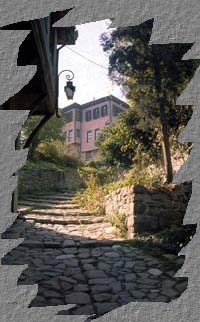 The Rennaissance town of Old Plovdiv was built during the 19th century. Today it has survived as a unique architectual ensemble on the three hills. Its houses reveal the remarkable urban culture of Bulgarian builders, as well as their sense of harmony and their creative power. The brilliant architecture with its noble, stylish simplicity could be called rightfully the Baroque of Plovdiv. The Bulgarian people have always been proud that Old Plovdiv was restored and preserved as a large open museum in order to stay for future generations. Today Old Plovdiv is an autonomous area within the modern town with a municipality of its own. It is declared an architectural museum reserve with over 150 monuments of culture - houses from the National Revival period. Its magnificent houses are turned into museums, galleries, workshops, restaurants, and pubs, such as "Puldin", "Trakijski Stan" , "Alafrangite", "The House
The Rennaissance town of Old Plovdiv was built during the 19th century. Today it has survived as a unique architectual ensemble on the three hills. Its houses reveal the remarkable urban culture of Bulgarian builders, as well as their sense of harmony and their creative power. The brilliant architecture with its noble, stylish simplicity could be called rightfully the Baroque of Plovdiv. The Bulgarian people have always been proud that Old Plovdiv was restored and preserved as a large open museum in order to stay for future generations. Today Old Plovdiv is an autonomous area within the modern town with a municipality of its own. It is declared an architectural museum reserve with over 150 monuments of culture - houses from the National Revival period. Its magnificent houses are turned into museums, galleries, workshops, restaurants, and pubs, such as "Puldin", "Trakijski Stan" , "Alafrangite", "The House 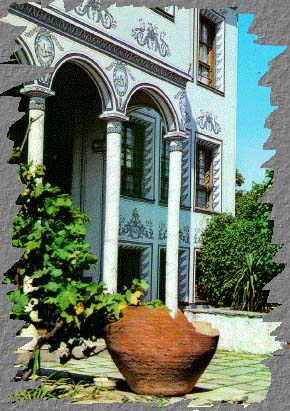 of Ritora", "The Old House". There are also parlours and studios of painters and wood-carvers. Families from Plovdiv own many of those houses. The most distinguished examples of the Baroque of Plovdiv are the house of Koiumjioglu (now an ethnographical museum), the house of Georgiadi (now the Rennaissance museum of the national struggle), the house of Nedkovich (the municipality), the house of Chomaka (the gallery of the renowned Bulgarian painter Zlatyo Boyajiev), the house of Balabanov (now a gallery of modern painting, as well as a concert hall), the house
of Ritora", "The Old House". There are also parlours and studios of painters and wood-carvers. Families from Plovdiv own many of those houses. The most distinguished examples of the Baroque of Plovdiv are the house of Koiumjioglu (now an ethnographical museum), the house of Georgiadi (now the Rennaissance museum of the national struggle), the house of Nedkovich (the municipality), the house of Chomaka (the gallery of the renowned Bulgarian painter Zlatyo Boyajiev), the house of Balabanov (now a gallery of modern painting, as well as a concert hall), the house  of Lamartin (the house of writers) where the French poet Alfonse de Lamartin stayed during his diplomatic mission in Turkey... The famous painting "Old Plovdiv" by Tzanko Lavrenov is probably the deepest revelation of the spirit, the excitement and the atmosphere of that fateful Bulgarian Rennaissance.
of Lamartin (the house of writers) where the French poet Alfonse de Lamartin stayed during his diplomatic mission in Turkey... The famous painting "Old Plovdiv" by Tzanko Lavrenov is probably the deepest revelation of the spirit, the excitement and the atmosphere of that fateful Bulgarian Rennaissance.
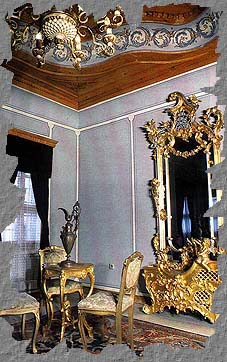 The wooden ceilings inside the houses of Plovdiv are carved, as if there is a sun in every room. Walls are polychromatically decorated. They have painted niches and fine, stylish European furniture. There is a kind of magic, some fine, fairly innocence in the spirit of Plovdiv. No wonder why UNESCO awarded Plovdiv a gold medal for architecture in 1979.
The wooden ceilings inside the houses of Plovdiv are carved, as if there is a sun in every room. Walls are polychromatically decorated. They have painted niches and fine, stylish European furniture. There is a kind of magic, some fine, fairly innocence in the spirit of Plovdiv. No wonder why UNESCO awarded Plovdiv a gold medal for architecture in 1979.
 Walking around Old Plovdiv, visitors enjoy the steep, cobbled streets and lanes with bow-windows and eaves above them. Facades are colored in harmonious combinations, with stylish patterns of white and blue. Windows have either wooden shuttles, or iron nets. Lovely gardens with plenty of green and flowers, fruit trees, old vines and figs, evergreen boxshrubs and roses under the shadows of old trees are hidden behind solid walls and heavy gates. Fancily colored pots of gullyflowers stand prominently behind windowpanes and upon sills.
Walking around Old Plovdiv, visitors enjoy the steep, cobbled streets and lanes with bow-windows and eaves above them. Facades are colored in harmonious combinations, with stylish patterns of white and blue. Windows have either wooden shuttles, or iron nets. Lovely gardens with plenty of green and flowers, fruit trees, old vines and figs, evergreen boxshrubs and roses under the shadows of old trees are hidden behind solid walls and heavy gates. Fancily colored pots of gullyflowers stand prominently behind windowpanes and upon sills. Wells are now only an exotic adornment. The babble of water running from old little fountains and taps breaks the silence. Tiny doors hidden within the thick walls lead to the neighbours' yards. All those beautiful colours of the narrow, patriarchal world of the past helped the Bulgarian ancestors to survive during the long decades of the yoke.
Wells are now only an exotic adornment. The babble of water running from old little fountains and taps breaks the silence. Tiny doors hidden within the thick walls lead to the neighbours' yards. All those beautiful colours of the narrow, patriarchal world of the past helped the Bulgarian ancestors to survive during the long decades of the yoke.
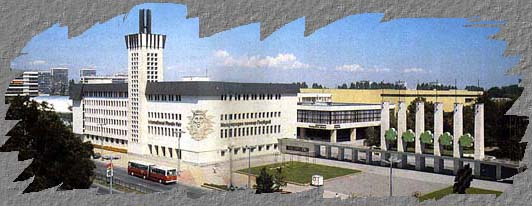
The first fair in Plovdiv was opened with gunfire on August 15, 1892. 36 woden pavilions, some of which from Vienna and Paris, were erected at the place of the present central park. The most luxury pavilion was from Karlovo. The pavilion from Pazarjik was shaped like a barrel in which good wines were offered. In the pavilion from Varna visitors were told how Bulgaria would be a tourist country one day - and that day became indeed. 168000 visitors saw the first fair that lasted 75 days. They were dazzled by the innovations.
It was not until the 30-s of our century that the fair was organized again by the Chamber of Trade and Industry in Plovdiv. In 1934 it became an annual fair of patterns and in 1935 it was proclaimed a single national fair. In the next year it became a member of the Union of International Fairs. The fifth national fair started on May 3, 1937 and it became the first International Plovdiv Fair. After a break during World War II the fair was organized again in 1947. Until 1966 the fair was held at various intervals; afterwards it became an annual event. The pavilions of the International Plovdiv Fair will expect exhibitioners and guests from all over the World each year between May 6-11 and September 23-28 and its prestigious gold medals will be awarded.
The Sports Center
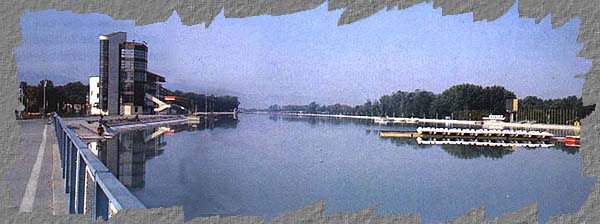
This state-of-the-art facility for water sports, almost 4 miles long, has been the host of many international competitions in rowing and kayak. Located in a park near the Plovdiv Zoo, it is a popular place for biking, fishing and recreation.
Last updated on